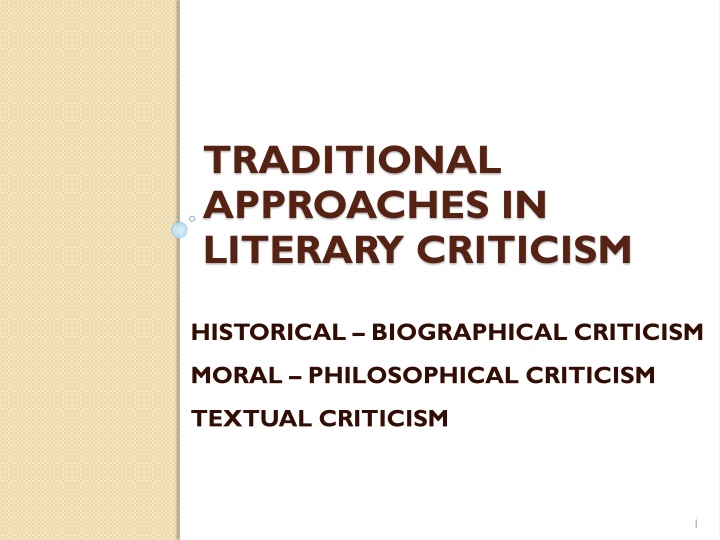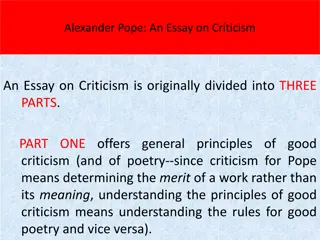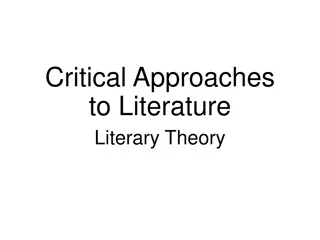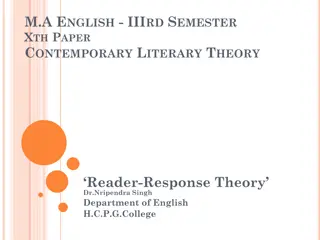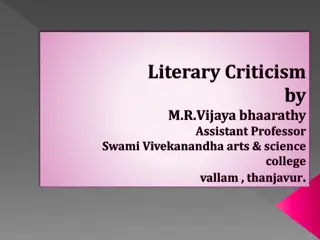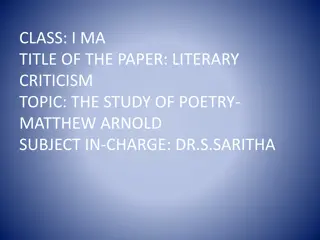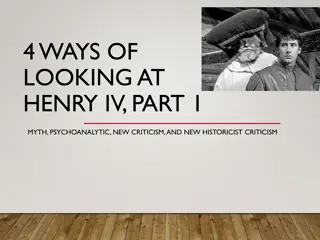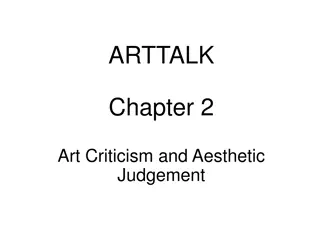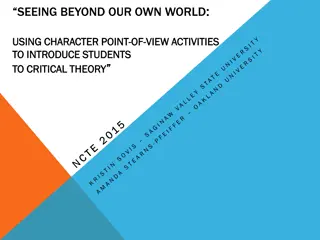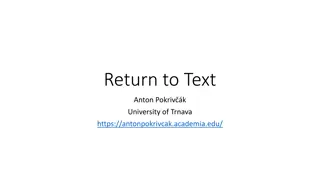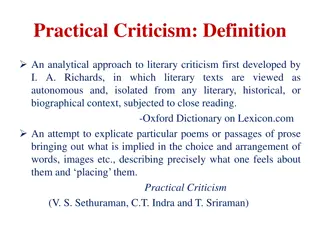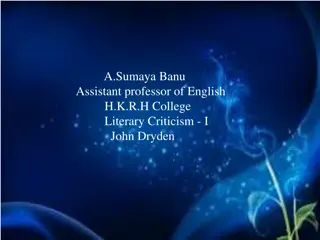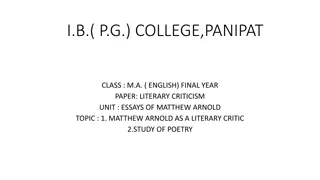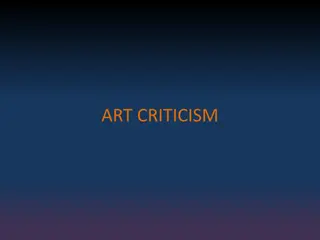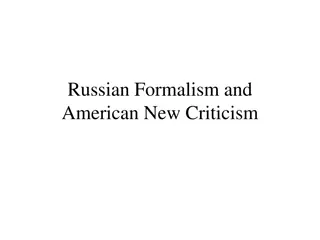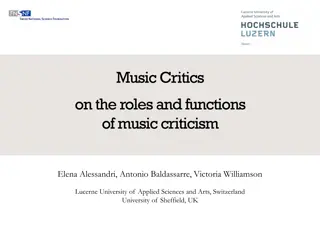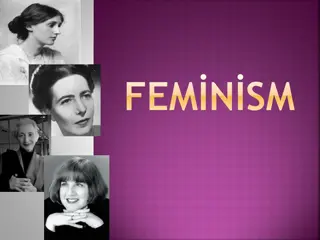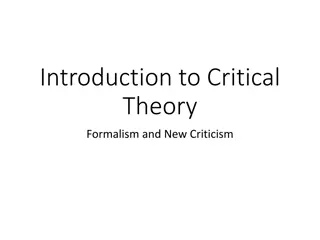Traditional Approaches in Literary Criticism: An Overview
Literary studies in the early 20th century were influenced by traditional approaches like historical, biographical, moral, philosophical, and textual criticism. These approaches focus on external information to interpret literary works, connecting them to broader contexts in fields such as history, philosophy, and authorial backgrounds.
Download Presentation

Please find below an Image/Link to download the presentation.
The content on the website is provided AS IS for your information and personal use only. It may not be sold, licensed, or shared on other websites without obtaining consent from the author.If you encounter any issues during the download, it is possible that the publisher has removed the file from their server.
You are allowed to download the files provided on this website for personal or commercial use, subject to the condition that they are used lawfully. All files are the property of their respective owners.
The content on the website is provided AS IS for your information and personal use only. It may not be sold, licensed, or shared on other websites without obtaining consent from the author.
E N D
Presentation Transcript
TRADITIONAL APPROACHES IN LITERARY CRITICISM HISTORICAL BIOGRAPHICAL CRITICISM MORAL PHILOSOPHICAL CRITICISM TEXTUAL CRITICISM 1
Literary studies in the first part of the 20th century were dominated by what are now called traditional approaches . American New Critics call extrinsic approaches to literature. They focus on understanding literary works by bringing external information to bear on them rather than by close and careful consideration of what is already expressed in the work itself. 2
To certain extent all approaches to literature are by definition extrinsic because a reader must have certain basic information at hand to read a literary work at all. At the vey least, a reader must know the language in which the work is written and must possess a certain basic amount of cultural knowledge. A reader must have at least a minimal understanding of the conventions of literature to process the content of a literary work in a coherent way. 3
We might compare the use of external information to aid in the interpretation of a literary text to the activities of a scientist who interprets a workings of nature. For instance, the beauty of the stars can be appreciated without being an expert in astronomy, but even the most seemingly naive appreciation of the beauty of nature involves a complex process of cultural conditioning. 4
More scholarly traditional approaches include a) biographical studies, in which a work is illuminated through a discussion of the experiences and opinions of its author b) philosohical studies, in which the ideas expressed in a literary text are compared to well-known philosophical concepts and often judged in relation to the critic s own moral or philosophical strance c) textual studies, in which the historical record is carefully sifted in an attempt to determine the precisely correct rendering of scale mechanical printing of literary texts. 5
In traditional approach the work of art frequently appears to be a source that illustrates background. Such an approach often leads to the study of literature as essentially biography, history, or some other branch of learning, rather than as art. According to those of the older school, literature provides primarily an opportunity for exercising what they perceive to be really relevant scholarly and cultural disciplines such as history, linguistics, biography and philosophy. 6
Historical-Biographical Approach Its focus is on the life, times, and environment of the author, and this approach deals with the effects of these factors on the work of art. Most of literary works can be analysed in the light of historical-biographical method. A reader/a critic studies the work in accordance with the period in which the work is produced. Thus, the values and perception of the reader s own age are put aside. 7
Historical-Biographical approach establishes a bridge between the reader and the world s of the author. The life of the author, the historical events and the values of his age help us understand the work, and in a similar way the literary work gives information of the author and his own period. 8
In his book History of English Literature, French critic Hippolyte A. Taine (1823- 1893) suggests the phrase race, millue, et moment a) Race stands for culture and history b) Millue is place c) Moment is time 9
This approach sees a literary work chiefly as a reflection of its author s life and times or the characters in the work. Taine compared the work of literature to the fossil of a leaf which tells the world of a previous age. 10
John Milton's sonnet On the Late Massacre in Piedmont illustrates the topical quality that great literature may and often does possess. This poem commemorates the slaughter in 1655 of the Waldenses, members of a Protestant sect living in the valleys of northern Italy. A knowledge of this background clarifies at least one rather factual reference and two allusions in the poem. 11
However, novels may lend themselves somewhat more readily than lyric poems to this particular interpretive approach; they usually treat a broader range of experience than poems do and thus are affected more by extrinsic factors. 12
It is a mistake, however, to think that poets do not concern themselves with social themes or that good poetry cannot be written about such themes. Actually, poets have from earliest times been the historians, the interpreters of contemporary culture, and the prophets of their people. For example, Blake's London is an outcry against the oppression of human beings by society: he lashes out against child labour in his day and the church's indifference to it, against the government's indifference to the indigent soldier who has served his country faithfully, and against the horrible and unnatural consequences of a social code that represses sexuality. 13
Moral-Philosophical Approach or Moral/Thematic Criticism The moral-philosophical approach is as old as classical Greek and Roman critics. Plato, for example, emphasized moralism and utilitarianism; Horace stressed that literature should be delightful and instructive. Among its most famous exemplars are the commentators of the age of neoclassicism in English literature (1660-1800), particularly Samuel Johnson. 14
The basic position of such critics is that the larger function of literature is to teach morality and to probe philosophical issues. They would interpret literature within a context of the philosophical thought of a period or group. This approach focuses on what is being taught. It asks the question: What kind of truth does this work reveal to us? 15
Roman critic Horace states in his Ars Poetica (The Art of Poetry) that literature should be dulce et utile or sweet and useful , it means literature should be both entertaining and enlightening. Sir Philip Sidney adopts the same view in literary criticism in his The Defence of Poesy: right poets imitate to teach and delight, and to imitate borrow nothing of what is, hath been or shall be, but range, only reined with learned discretion, into the divine consideration of what may be and should be . 16
Matthew Arnold, the Victorian critic, adopted a related attitude; he insisted that a great literary work must possess high seriousness (Because he felt that Chaucer lacked it, Arnold refused to rank him among the very greatest English poets).In each instance critics working from a moral bent are not unaware of form, figurative language, and other purely aesthetic considerations, but they consider them to be secondary. 17
The important thing is the moral or philosophical teaching. On its highest plane this is not superficially didactic, though it may at first seem so. In the larger sense, all great literature teaches. The critic who employs the moral- philosophical approach insists on ascertaining and stating what is taught. If the work is in any degree significant or intelligible, this meaning will be there. 18
TEXTUAL STUDIES or TEXTUAL SCHOLARSHIP This approach can be considered as the beginning of New Critisim. In this criticism the text is analysed in terms of the work of the author , in other words the critic studies what urges the author to write such a work, what influences him, and what kind of historical motives are reflected. 19
Textual criticism has as its ideal the establishment of an authentic text, or the text which the author intended . There are countless ways in which a literary text may be corrupted from what the author intended. The author s own manuscript may contain omissions and errors in spelling and mechanics; these mistakes may be preserved by the text copyists, be they scribes, or compositors, or scanners, who may add a few of their own. 20
Applying Traditional Approaches on a Text Shakespeare s Hamlet is the quintessence of traditional criticism. Some of the critics think that Shakespeare draws attention to the potential problem of succession after the death of Queen Elizabeth. Elizabeth s advanced age and poor health may have led the playwright to write such a work. 22
Polonius is considered to be related to Burghley (Lord Treasurer), one of the important politicians of Elizabethan Time. Burghley possessed most of the shortcomings Shakespeare gave to Polonius; he was boring, meddling, and given to wise old adages and truisms. Moreover, he had an elaborate spy system that kept him informed about both friend and foe. In the play Polonius assignes Reynaldo to spy his son Laertes in Paris. 23
Shakespeare creates such a character to criticise Burgley, and he protrays the lord after his death in 1598. Apart from the historical events or figures, Shakespeare s own thoughts are reflected, as well. As a dramatist, he criticises the dramatic activity of the period and the attitudes of the players because the private theatre employed children and constituted a rival for the adult companies of the public theater, for which Shakespeare wrote. That s why Hamlet attacks the players because of their repertoire. 24
Moreover, Shakespeare portrays some courtiers as stock characters (Osric, Rosencrantz and Guildenstern) in the play to show that they are weak characters who could not make their own decisions, instead just puppets in hand of the authority. 25
The Danish court of the period could be studied in terms of traditional criticism, as well. The question in the play is succession, so one should focus on how the Danish court solves such a problem. And the critic should learn what he needs to know about Elizabethan England to understand this play. 26
The critic should not miss that Hamlet does not succeed to throne after the death of his father even though he is the only son. In Hamlet s day the Danish throne was an elective one. The royal council, composed of the most powerful nobles in the land, named the next king. The custom of the throne s descending to the oldest son of the late monarch had not yet crystallized into law. 27
In the light of traditional criticism, also the moral and philosophical aspects of the play should be analysed. The play emphasises that some humans are so ambitious for a crown that they are willing to murder for it and that others are so highly sexed that they will violate not only the laws of decorum but also the civil and ecclesiastical laws against incest. 28
Another point is that as an intellectual, Hamlet is in search of revenge. It is obvious that his philosophical knowledge and Christian religion should hinder him and he must realise that revenge is wrong. However, Hamlet never gives up the idea of taking revenge because he is a transitional figure between his feudal son identity and intellectual man. 29
Conclusion Traditional approaches analyse a work of art as the mirror of the author and the society of the period in which it is written. Studying the historical events of the period, getting information about the author s life and experiences could help us understand what the text explains and what the author intends. 30
A reader who stays more or less on the surface of a piece of literature has at least understood part of what it is about. Ones who intend to employ the traditional approaches to a literary work will almost certainly employ them simultaneously. That is, they will bring to bear on a poem, for instance, all the information and insights these respective disciplines can give in seeing just what the poem means and does. 31
BIBLIOGRAPHY Booker, Keith M. A Practical Introduction to Literary Theory and Criticism. London: Longman Publishers, 1995. Guerin, Wilfred L., et al. A Handbook of Critical Approaches to Literature. New York: Oxford UP, 2005. 32
